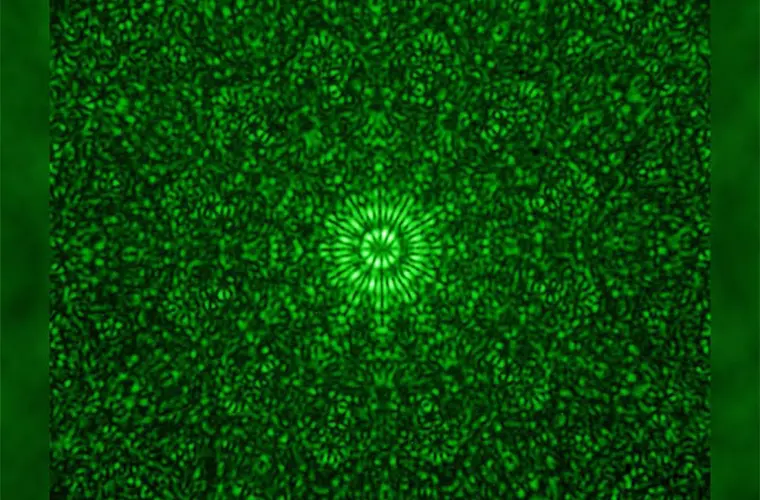Imagine transmitting massive amounts of data, not through traditional wires or wireless signals but through tiny “hurricanes of light.” This is precisely what researchers at Aalto University in Finland have achieved by pioneering an extraordinary technique for creating microscopic light vortices capable of carrying information at high speed and efficiency.
These laser-generated vortices, designed to operate almost microscopically, promise to open new avenues in optical data transmission, potentially revolutionizing fields from telecommunications to secure data handling.
“This research is on the relationship between the symmetry and the rotationality of the vortex, i.e., what kinds of vortices can we generate with what kinds of symmetries,” Dr. Päivi Törmä, a professor of applied physics at Aalto University and study co-author explained in a release. “Our quasicrystal design is halfway between order and chaos.”
In findings recently published in Nature Communications, scientists at Aalto University’s Department of Applied Physics announced the creation of minuscule “light vortices,” or topological vortices that can act as information carriers.
These vortices, shaped like hurricanes of light, offer an intriguing new way of encoding and transmitting data, possibly marking a transformative step for high-speed data transfer systems.
The discovery holds promise for advancing optical communications—one of the cornerstones of modern data infrastructure—as these new vortices enable information to be carried with remarkable stability and resilience.
For decades, data transmission has primarily relied on electronic and fiber-optic channels, with data being encoded and transmitted as pulses of light through cables.
However, as our data demands grow exponentially, researchers are exploring novel methods to expand the amount of information that can be packed into each pulse of light.
This latest development from Aalto University could reshape the landscape. By leveraging quasicrystal designs to produce stable vortices or “hurricanes of light” with high “topological charge”—an index of how much a vortex twists as it propagates—scientists are tapping into new physics principles to increase data capacity and integrity.
The team, led by doctoral researchers Kristian Arjas and Jani Taskinen, achieved this by designing and fabricating plasmonic quasicrystals, which exhibit unique rotational symmetries not found in regular crystals.
This arrangement enables the creation of vortices with remarkably high topological charges, an achievement that has been a significant technical barrier until now.
By focusing on structures with rotational symmetries like eight- and ten-fold symmetries, the researchers engineered quasicrystals capable of supporting vortices with charges of up to ±19.
This high charge, a measure of the phase twist in the light’s electric field, makes each vortex extraordinarily stable and resistant to interference, a crucial quality for data transfer applications.
The technology hinges on creating what the researchers call “polarization vortex beams.” These are beams of light whose polarization—or the orientation of their electric fields—rotates around a central axis with a calm and dark center, much like a spinning hurricane.
The Aalto team’s innovation lies in using quasicrystals, structures with rotational but not translational symmetry. Unlike regular crystals, these quasicrystals can support rotational symmetries beyond the six-fold symmetry limit found in traditional crystalline lattices.
Quasicrystals are unique in their symmetry and inherently dampen certain types of light while allowing specific high-topological-charge modes to shine. By strategically placing nanoparticles within the quasicrystal’s framework, the researchers could amplify the desired vortex-like light patterns while suppressing others, effectively creating a system that favors the high-charge vortices needed for robust data transmission.
This technology’s potential applications span a range of fields where high-bandwidth, stable, and interference-resistant data transmission is essential.
In telecommunications, these vortices could provide an additional layer of encoding within light waves, dramatically increasing the information each wave can carry. This could enhance the capabilities of existing fiber-optic networks, enabling them to handle larger volumes of data without the need for costly infrastructure upgrades.
Additionally, the unique properties of these vortices—stability and topological protection—could make them invaluable in applications requiring secure data transmission.
These tiny hurricanes of light with high topological charges are inherently more resilient against environmental perturbations, making them ideal for secure data channels in finance, healthcare, and defense industries.
“We could, for example, send these vortices down optic fiber cables and unpack them at the destination. This would allow us to store our information into a much smaller space and transmit much more information at once,” Arjas explained. “An optimistic guess for how much would be 8 to 16 times the information we can now deliver over optic fiber.”
The implications of this research extend beyond classical data transmission. In the realm of quantum computing, where information is stored in quantum states that are often highly sensitive to interference, stable topological vortices could serve as robust carriers for quantum information. As light vortices resist perturbations, they may provide a novel way to encode and transmit quantum information over long distances, a key challenge in developing a global quantum internet.
According to the researchers, the design principles used to create these high-charge vortices are adaptable and could be applied to various materials beyond the plasmonic structures used in the current study.
This adaptability suggests that the technology could eventually be used with semiconductor materials and even integrated into compact devices, paving the way for practical applications in classical and quantum data systems.
As the team continues to refine its technology, one goal is to design quasicrystals capable of supporting even higher topological charges.
While this technology is still in its experimental stages, its potential to transform how we transmit, secure, and process information is remarkable.
From creating high-resilience data vortices to encoding quantum information for secure communications, these hurricanes of light mark an exciting frontier in the science of information transfer.
The research team’s success in generating these high-charge light vortices is a testament to the potential of advanced material design and physics to shape the future of data technology.
As industries demand ever-greater data transmission capabilities, these hurricanes of light could one day become an integral part of the global data infrastructure.
Tim McMillan is a retired law enforcement executive, investigative reporter and co-founder of The Debrief. His writing typically focuses on defense, national security, the Intelligence Community and topics related to psychology. You can follow Tim on Twitter: @LtTimMcMillan. Tim can be reached by email: tim@thedebrief.org or through encrypted email: LtTimMcMillan@protonmail.com

